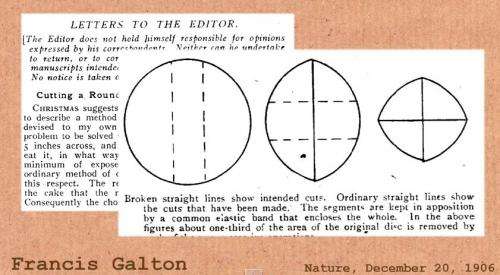June 19, 2014 weblog
Cutting a round cake with knife, elastic bands and principles

(Phys.org) —There is a good way and a bad way to cut cake. Ask Alex Bellos the author of The Grapes of Math: How Life Reflects Numbers and Numbers Reflect Life. Bellos talks about scientific principles governing a better way to cut a cake then taking a knife to just slice into a cake's circle shape for serving triangular wedges. The classic cut-into-wedges way is the bad way. In a Numberphile instructional video, first taking a knife, and going up to the center and creating a slice, appears to be just fine but he reveals why it is not fine: After cutting out the wedge as a slice, if you place the rest of the cake in the fridge to keep overnight, on the next day you find that the part of the cake closest to the opening where you had sliced is dry. So that leftover slice which you aim to cut next has one side of which is soft and the other hard. "You are not maximizing the gastronomic pleasure," said Bellos.
Now for the best way. Bellos said the explanation for the best way is actually over 100 years old, thanks to one of Britain's mathematical scientists, he said, Francis Galton, who sent a letter to the editor about his cake-cutting idea, which was published in Nature. Bellos displayed a copy of the letter, from 1906, titled "Cutting a Round Cake on Scientific Principles."
Galton wrote that Christmas suggests cakes, and he wished to point out that the ordinary way of cutting out a wedge was faulty. His suggestion for the mathematically perfect way to cut a round cake is to cut two long narrow slices out of the middle of the cake first, in that you remove the two slices that you just cut parallel down the middle, leaving the two large separated cake parts, which you then close together gently with your hands and secure with rubber bands. The following day, when proceeding to cut another slice, you repeat the same task, cutting two long parallel slices down the middle, closing up the cake with your hands, and securing it once again with a rubber band, and so on.
Many comments about the video posted on various sites included questions of how could this be relevant if you have a lifestyle that includes the presence of family or friends or both?. How typical would it be to serve a small cake and on the same day have anything but crumbs left over? Galton, even back then, was apparently aware of different situations and made it a point to state in his letter that the cake-cutting problem which he modeled to be solved involved a round cake and two persons of moderate appetite to eat it.
Bellos offered a few extra words about Galton, in an extra-slice video from Numberphile: He said that Galton "was obsessed with measuring. He had a lab in Kensington where he would just measure people.—size of head, strength of punch." He found some interesting patterns. A voice off camera asked Bellos, "Then what was he doing writing letters to Nature about cutting cakes?" Bellos said: "Tea time is very important for the British." Galton loved tea and he tried to figure out the perfect way to make tea but could not work it out. He turned his attention instead to a scientific way of cutting cake, a companion, Bellos said, to a nice cup of tea.
More information: www.numberphile.com
Journal information: Nature
© 2014 Phys.org

















